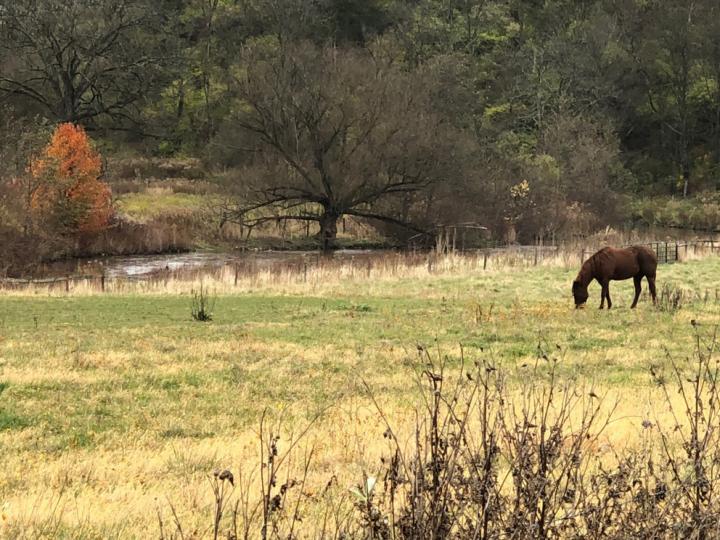
Credit: Sue Morgan
Using site-specific watershed data to determine the most cost-effective agricultural best management practices — rather than requiring all the recommended practices be implemented across the entire watershed — could make staying below the Chesapeake Bay’s acceptable pollution load considerably less expensive.
That’s the conclusion of a novel, five-year study conducted by an interdisciplinary team of Penn State and U.S. Department of Agriculture researchers, who modeled and compared runoff and pollution from Spring Creek watershed in central Pennsylvania under two scenarios: using all of the best management practices ( BMPs) identified for a watershed and a customized, most cost-effective set of BMPs tailored for Spring Creek watershed.
One of the criticisms of the U.S. Environmental Protection Agency’s Chesapeake Bay model is that it is too “coarse” in its simulation of all of the landscapes that have runoff and drainage from agriculture, explained Heather Karsten, associate professor of crop production and ecology in the College of Agricultural Sciences.
She noted that the current policy approach does not capture fine-scale features of landscapes, nor does it identify the most cost-effective BMPs to most efficiently protect water quality by reducing sediment and nutrient loss.
“By identifying which practices reduce sediment and nutrient losses at the lowest cost to farmers and applying some of these practices in the most appropriate agricultural landscapes in Spring Creek watershed — such as those that are steep sloped or close to stream banks — farmers could reduce sedimentation and nutrient loss for 26% less money,” she said. “By looking at smaller watersheds individually, we have many opportunities to understand what is happening on the landscape and to develop cost-effective and strategically effective practices that could be adopted to protect water quality and meet federal water-quality goals.”
Researchers used the Spring Creek watershed — which drains an area of about 150 square miles into Bald Eagle Creek, a tributary of the Susquehanna River — for the project because it is one of the best studied watersheds in the Chesapeake drainage, and a great deal of data has been accumulated about stream flows, nutrient and sediment loss, and the landscape there. Penn State and USDA scientists, along with the U.S. Geological Survey, have monitored the Spring Creek watershed closely for decades.
Using a system called the Topo Soil Water Assessment Tool, which is calibrated for Spring Creek’s geology, researchers crafted an extremely detailed picture of the watershed’s hydrologic characteristics and results achieved by best management practices implemented there. The tool was developed by lead researchers Mostofa Amin, who was a postdoctoral scholar at Penn State when the study was conducted, and Tamie Veith, an agricultural engineer with USDA’s Agricultural Research Service.
For the Spring Creek watershed, researchers evaluated the cost of reducing soil, nitrogen and phosphorus losses using the eight major agricultural BMPs recommended in the Pennsylvania watershed implementation plan, informed by the Chesapeake Bay Model. The eight BMPs included no-till planting, manure injection, cover cropping, riparian buffer installation, land retirement, manure-application timing, wetland restoration and nitrogen management that results in 15% less nitrogen input.
By using the customized Spring Creek model, the scientists designed a cost-effective BMP adoption scenario that achieved equal or greater load reduction as the federal requirements for 74% of the cost by applying just five of the BMPs — no-till, manure injection, cover cropping, riparian grass buffers and 15% reduction in nitrogen inputs.
“Because watersheds of this size typically represent the smallest unit in the Chesapeake Bay Model, results demonstrate the potential to use watershed models with finer scales to rank the cost-effectiveness of BMPs and achieve the Chesapeake Bay Total Maximum Daily Load, or TMDL, at a lower cost,” said Amin.
The researchers hope federal policymakers will consider the study’s findings, recently published in the Journal of Environmental Quality, and recognize that cost-effective ranking of best management practices with fine-scale watershed models can enable states such as Pennsylvania to get more bang for their buck as they struggle to meet the Chesapeake Bay TMDL.
“This research would not have been possible were it not for the close collaboration between Penn State and USDA scientists based at the University Park campus who were members of the Center for Nutrient Solutions funded by EPA,” said Karsten. “We had an interdisciplinary team of people who understand the policy arena, have done field and theoretical research related to best management practices, and could understand, with valuable input from community stakeholders, the opportunities and challenges associated with the suite of BMPs for Spring Creek watershed.”
These findings have significant implications for the entire bay drainage, she added.
###
Also involved in the research were James Shortle, distinguished professor of agricultural and environmental economics, and Robert Brooks, professor of geography and ecology, both at Penn State; and Peter Kleinman, USDA Agricultural Research Service, Pasture Systems and Watershed Management Research Unit.
The research was supported by EPA and USDA.
Media Contact
A’ndrea Elyse Messer
[email protected]
814-865-5689
Related Journal Article
http://dx.




